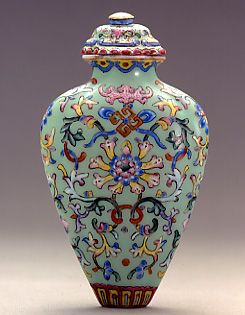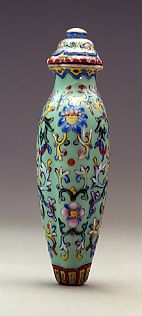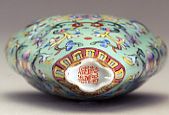


Bottle ID: 00471
ENAMELED FAMILLE ROSE, LOTUS, FLORAL SCROLLS & BAT
Date: 1760-1799
Height: 65 mm
Porcelain, hard paste, of elongated tapering shield shape with raised front and back panels, the shoulders tapering to a quatrefoil shaped mouth, and sloping to a quatrefoil shaped indented base; decorated in famille rose enamels on a pale opaque duck-egg green ground on each side with a central formalized lotus surrounded by floral scrolls, beneath a bat suspending a ribboned Buddhist swastika, the base with a band of formalized lotus petals, the neck with a band of lingzhi fungus heads; the foot with a four character iron-red Qianlong nianzhi mark in seal script and of the period.
Imperial, attributed to the Palace Workshops, Jingde Zhen.
Similar Examples:
Crane Collection no. 518.
Chang Lin-sheng. Snuff Bottles in the Collection of the National Palace Museum, Taipei, Taiwan, 1991, p. 115, no. 75; p. 120, no. 84; p. 122, no. 86; and p. 124, no. 88.
Beijing Hanhai Art Auction Corp., October 24, 1996, lot 27.
Provenance:
Hugh Moss [HK] Ltd.
Johnny Tseng, March 2002
Unrecorded Collector
Christie's, New York, October 18, 1993, lot 2
The Reif Collection
Christie, Manson & Woods, St. James's London, June 14, 1971, lot 8
The Ko Family Collection
Exhibited:
Annual Convention ICSBS Toronto, October 2007
The Qianlong Emperor began ordering snuff bottles made at the Imperial porcelain factory at Jingde Zhen during the 1740s and such orders continued throughout his reign, and that of his two successors. Although it was previously thought that these bottles were made in sets of ten or twenty since they still exist in the Palace Museums in boxes of those numbers of bottles, it is apparent from the translations of the Imperial Archives that these boxes, albeit of high quality, were essentially packaging for the bottles made in Jingde Zhen and sent up to the Palace. Many of those from the Qianlong and Jiaqing reigns have formalized floral designs, some, such as this example, inspired by cloisonné enamels with even the gilded wires of that medium imitated in the porcelain equivalents. However, there appears to be no other identical example in today's collections. Similar bottles from the same period that have survived in the Imperial Collection are mostly still in their original boxes and have never been used, but many others were distributed as gifts. The form of this bottle is highly unusual, with its very narrow foot and lobed body.
< Back to full list
 English
English 中文
中文